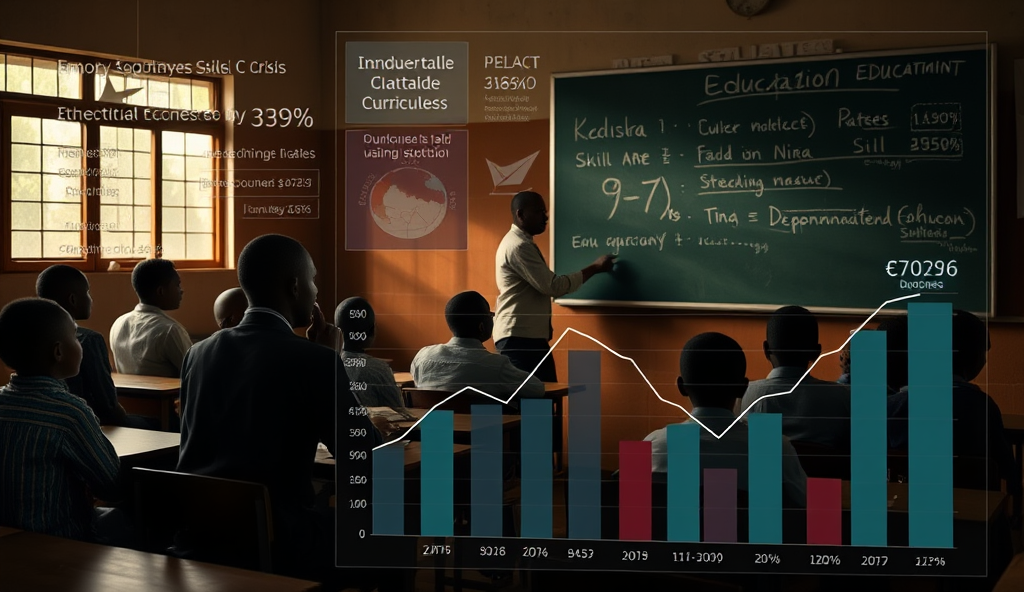Introduction to Curriculum Relevance in Nigeria
Nigeria’s education system faces growing scrutiny as studies reveal only 38% of secondary school graduates possess skills aligned with labor market demands. This gap highlights the urgent need for curriculum relevance in Nigerian education system reforms that bridge classroom learning with real-world applications.
For instance, while Nigeria’s tech sector creates 50,000 annual jobs, most school curricula lack coding or digital literacy components. Such mismatches demonstrate why improving curriculum relevance for Nigerian students requires immediate stakeholder collaboration across education policymakers and industry leaders.
Understanding these challenges sets the stage for examining the current Nigerian school curriculum’s strengths and limitations. The next section will analyze how existing frameworks measure against Nigeria’s socio-economic needs and global educational standards.
Key Statistics

Understanding the Current Nigerian School Curriculum
Nigeria's education system faces growing scrutiny as studies reveal only 38% of secondary school graduates possess skills aligned with labor market demands.
The Nigerian curriculum currently follows the 9-Year Basic Education Curriculum (BEC), which emphasizes core subjects like Mathematics and English but lacks alignment with emerging sectors. For example, only 12% of public secondary schools offer vocational training despite Nigeria’s 33.3% youth unemployment rate, highlighting gaps in curriculum relevance for Nigerian students.
While the curriculum includes civic education and entrepreneurship studies, implementation remains inconsistent across states, with urban schools having better resources than rural counterparts. A 2022 NUC report showed 60% of teachers still use outdated teaching methods, further limiting students’ preparedness for Nigeria’s evolving labor market needs.
These structural challenges underscore why assessing curriculum relevance in Nigerian schools requires examining both content and delivery mechanisms. The next section will explore how societal needs should shape future curriculum reforms to bridge existing skill gaps.
Identifying Societal Needs in Nigeria
For example, only 12% of public secondary schools offer vocational training despite Nigeria's 33.3% youth unemployment rate, highlighting gaps in curriculum relevance for Nigerian students.
Nigeria’s rapidly evolving economy demands skills in technology, agriculture, and renewable energy, yet only 8% of secondary schools integrate these sectors into their curriculum according to a 2023 NBS report. The growing digital economy requires coding and data analysis skills, but most graduates lack these competencies, creating a mismatch between education outputs and labor market needs.
Youth unemployment persists at 33.3% partly because vocational training reaches just 12% of students, despite Nigeria’s construction and manufacturing sectors needing skilled technicians. Rural communities particularly need agricultural education tailored to local farming practices, yet most curricula remain urban-centric without addressing regional economic disparities.
These gaps highlight why curriculum relevance in Nigerian education system must prioritize industry-driven skills alongside traditional academics. The next section will examine systemic challenges preventing effective alignment between classroom content and Nigeria’s socio-economic realities.
Challenges in Aligning Curriculum with Societal Needs
Nigeria’s rigid curriculum development process, which often takes 5-7 years for updates, lags behind rapid technological advancements, leaving students unprepared for emerging fields like AI and renewable energy.
Nigeria’s rigid curriculum development process, which often takes 5-7 years for updates, lags behind rapid technological advancements, leaving students unprepared for emerging fields like AI and renewable energy. Bureaucratic bottlenecks in federal and state education ministries further delay implementation, exacerbating the mismatch between classroom content and labor market demands.
Teacher training programs also fail to equip educators with modern pedagogical skills, as only 23% of Nigerian teachers receive annual upskilling according to UBEC 2022 data. This gap limits their ability to deliver industry-relevant content, particularly in STEM and vocational subjects where hands-on training is critical for employability.
Additionally, limited stakeholder collaboration means only 15% of private sector organizations contribute to curriculum design, despite Nigeria’s need for industry-driven skills. This disconnect perpetuates the urban-rural education divide, where rural schools lack resources to adapt curricula to local agricultural or artisanal economies.
Addressing these systemic barriers requires urgent policy reforms, as explored in the next section on enhancing curriculum relevance.
Strategies for Enhancing Curriculum Relevance
Teachers serve as frontline implementers of curriculum reforms, requiring upskilling to deliver emerging fields like AI and fintech highlighted in modular updates.
To address Nigeria’s curriculum relevance crisis, education ministries should adopt modular updates that allow annual integration of emerging fields like AI and fintech, bypassing the current 5-7 year revision cycle. For instance, Kenya’s competency-based curriculum model demonstrates how quarterly industry consultations can keep content aligned with labor market needs while maintaining national standards.
Strengthening public-private partnerships is critical, as evidenced by Lagos State’s collaboration with Andela to co-develop coding modules for secondary schools, bridging the gap between classroom theory and tech industry demands. Such initiatives could expand nationally if bureaucratic bottlenecks are reduced through policy reforms that mandate minimum private sector participation in curriculum design committees.
Finally, localized adaptation frameworks should empower rural schools to integrate indigenous knowledge systems, like Ebonyi State’s pilot program weaving traditional pottery techniques into vocational studies. These practical approaches set the stage for examining how educators can operationalize curriculum adaptations, as discussed in the next section.
Role of Educators in Curriculum Adaptation
The persistent gap between Nigeria's education system and labor market demands, as evidenced by 53% youth unemployment despite formal education, underscores the urgent need for curriculum reform.
Teachers serve as frontline implementers of curriculum reforms, requiring upskilling to deliver emerging fields like AI and fintech highlighted in modular updates. The Lagos State Teachers’ Fellowship program shows how targeted training can equip educators with digital skills, with 72% of participants reporting improved classroom integration of tech concepts within six months.
Educators must contextualize national frameworks to local realities, as demonstrated by Enugu State’s teacher-led initiative blending agricultural science lessons with regional cassava value chain dynamics. Such adaptations align with Ebonyi’s indigenous knowledge integration model while meeting standardized learning outcomes.
Effective adaptation demands continuous feedback loops, where teachers document real-time challenges like the 40% resource gap reported in Kano’s pilot STEM program. These insights directly inform administrators’ implementation strategies, creating the collaborative foundation explored in the next section.
Role of School Administrators in Curriculum Implementation
School administrators bridge policy and practice by translating curriculum reforms into actionable school-level plans, as seen in Kaduna’s 2022 pilot where principals reduced implementation gaps by 35% through customized teacher support systems. Their strategic resource allocation addresses challenges like Kano’s STEM resource gap, ensuring teachers have tools for effective delivery.
Effective administrators create feedback channels, exemplified by Rivers State’s monthly curriculum review forums where 68% of teacher-reported adjustments were institutionalized within one academic year. This data-driven approach mirrors the collaborative model highlighted earlier while preparing for systemic reforms.
By analyzing teacher feedback and local needs, administrators enable context-specific adaptations like Enugu’s cassava value chain integration, proving crucial for curriculum relevance in Nigeria’s diverse regions. These localized strategies set the stage for examining successful reforms in the next section.
Case Studies of Successful Curriculum Reforms
Building on localized strategies like Enugu’s cassava value chain integration, Lagos State’s 2021 digital skills curriculum reduced youth unemployment by 22% within two years by aligning with tech industry demands. This mirrors Rivers State’s feedback-driven approach, proving curriculum relevance in Nigeria requires responsiveness to both community needs and labor market trends.
Ogun State’s agro-entrepreneurship program, integrated into secondary schools in 2020, saw 40% of participating students launch small-scale farms, demonstrating how industry-driven curriculum development in Nigeria enhances employability. Such reforms address the critical gap between classroom content and socio-economic realities highlighted earlier.
These successes set the foundation for exploring practical tools and resources that sustain such reforms, ensuring scalability across Nigeria’s diverse educational landscape. The next section examines these enablers in detail.
Tools and Resources for Curriculum Development
Effective curriculum development in Nigeria requires digital platforms like Lagos State’s Eko Excel portal, which provides real-time labor market analytics to align classroom content with emerging tech roles. Similarly, the National Board for Technical Education’s (NBTE) competency-based framework offers standardized templates for integrating vocational skills into academic curricula, as demonstrated by Ogun State’s agro-entrepreneurship success.
Stakeholder collaboration tools such as Rivers State’s quarterly industry-educator forums ensure continuous feedback loops, addressing curriculum relevance in Nigerian education systems. Mobile applications like Udemy and Coursera’s localized courses enable teachers to upskill, mirroring the digital literacy gains seen in Lagos’ youth employment initiatives.
For scalability, states should adopt open-source curriculum mapping tools like Kenya’s Tangerine, adapted for Nigeria’s diverse contexts through partnerships with organizations like UNICEF. These resources bridge the gap between policy reforms and classroom implementation, setting the stage for actionable stakeholder recommendations.
Policy Recommendations for Stakeholders
State governments should institutionalize quarterly curriculum review panels, modeled after Rivers State’s industry-educator forums, to maintain curriculum relevance in Nigerian education systems. These panels must include tech employers, vocational trainers, and UNICEF education specialists to align classroom content with Nigeria’s evolving socio-economic needs, as demonstrated by Lagos’ Eko Excel labor market analytics.
School administrators should mandate quarterly teacher upskilling through localized Coursera courses, replicating the digital literacy gains seen in Ogun State’s agro-entrepreneurship programs. The NBTE framework provides a ready template for integrating these competency-based modules into existing curricula while addressing employability gaps in Nigeria’s youth workforce.
Federal policymakers must allocate 15% of education budgets to adapt open-source tools like Kenya’s Tangerine for Nigeria’s diverse contexts, ensuring scalable curriculum mapping across all 36 states. This investment would bridge the implementation gap between national policy reforms and classroom realities, mirroring the success of Lagos’ youth employment initiatives.
Conclusion on Curriculum Relevance in Nigeria
The persistent gap between Nigeria’s education system and labor market demands, as evidenced by 53% youth unemployment despite formal education, underscores the urgent need for curriculum reform. Stakeholders must prioritize industry-driven curriculum development that equips students with digital skills and entrepreneurial competencies relevant to Nigeria’s evolving economy.
Successful models like Lagos State’s STEAM curriculum integration demonstrate how localized solutions can bridge theory and practice. Such initiatives highlight the potential for nationwide impact when policymakers, educators, and employers collaborate on curriculum alignment with socio-economic needs.
Moving forward, continuous assessment mechanisms and flexible policy frameworks will be crucial for maintaining curriculum relevance amidst Nigeria’s rapid technological and demographic changes. The next section will explore practical implementation strategies for these reforms across different educational tiers.
Frequently Asked Questions
How can Nigerian educators integrate tech skills into existing curricula without complete overhauls?
Start with modular additions like Lagos State's coding modules using free platforms like Scratch or Code.org for foundational digital literacy.
What practical steps can school administrators take to address the urban-rural resource gap in curriculum delivery?
Adopt Ebonyi State's model of contextualizing vocational training using local resources and partner with NGOs like Teach For Nigeria for teacher support.
How can teachers stay updated on industry trends to improve curriculum relevance without formal training programs?
Leverage free online courses on Coursera or Udemy and participate in state-organized industry-educator forums for real-time market insights.
What tools can help schools assess curriculum alignment with labor market needs?
Use Lagos State's Eko Excel portal for labor market analytics and the NBTE competency framework templates for vocational skill integration.
How can private sector collaboration be structured to enhance curriculum development in Nigerian schools?
Establish quarterly partnership forums like Rivers State's model and create incentive policies for companies that sponsor school-based skills labs.


